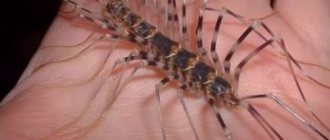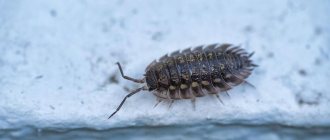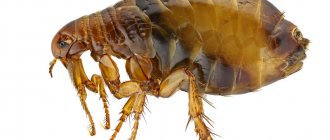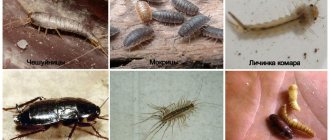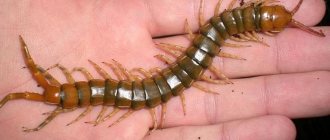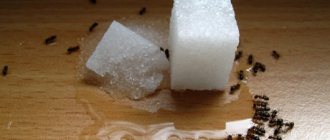Throughout life, the human home attracts many insects, since they can hide in it, spend the winter and find something to eat. At the same time, there is the appearance of many, sometimes dangerous insects, the proximity of which does not bode well. As for the centipede, it is the most harmless creature that can be found in a person’s home. Moreover, such a neighborhood can bring a positive effect, although few people know about it.
Therefore, first of all, the centipede scares apartment residents with its not very attractive appearance: the body is long and sinuous with many legs. Fear arises because practically no one knows what kind of insect this is and what to do with it. This article explains what this insect is and how to deal with it.
What centipedes live next to humans?
Apartments and houses are inhabited mainly by common flycatchers or centipedes; under favorable conditions, they may not leave their homes and spend their entire lives in them, and this is neither more nor less, but 6-7 years.
flycatcher
The centipede, contrary to its name, does not have 40 legs. In an adult, the body is divided into 15 segments, each of which has a pair of long striped legs attached. They are so thin at the ends that it is simply amazing how they can support the weight of a centipede. The last pair of legs exceeds the size of the flycatcher itself, which is why it is not immediately possible to recognize where its antennae are and where its legs are.
The flattened body is light brown or yellow in color with longitudinal dark stripes, the length reaches 6 cm. Compounded eyes are located on the sides of the head. Keen vision and fast movement speed provide the centipede with excellent hunting abilities. By nature, arthropods are predators. Small insects become its prey. In apartments these can be cockroaches, bedbugs, fleas, flies. With its legs, the flycatcher captures prey, injects poison into it and absorbs the immobilized trophy.
Interesting! Centipedes do not belong to the class of insects, but are included in the class of labiopods. But given that all small-sized crawling and flying representatives of the fauna are commonly called insects, in everyday life centipedes are also classified among them.
Scolopendra domestica
Scolopendras are one of the most interesting creatures among centipedes. In Southern Europe, in the Crimea, the ringed scolopendra lives and takes root well in colder latitudes. Unlike their tropical “relatives,” these centipedes in the house do not pose a threat to the life or health of people and eat synanthropic insects. Only occasionally can they accidentally bite a sleeping person. Their sting has much in common with that of a bee. The affected area experiences burning, pain, redness and swelling.
On a note! A heating pad with water at 45°C will help reduce pain after a scolopendra bite. According to scientists, heat exposure destroys the arthropod's venom.
Lifestyle
A centipede is an arthropod that has a unique lifestyle, habitat and food preferences.
Where does it live?
The common flycatcher is found where the climate is temperate. Millipedes can live in Europe, the Middle East and northern Africa. They prefer to hide under stones, fallen leaves or plant debris. The house centipede primarily hunts at night.
Common flycatchers flock to people's houses and apartments with the arrival of cold weather.
Choose dark and damp places to live:
- basements;
- bathrooms;
- restrooms.
Despite their appearance, centipedes are not the most harmful living creatures trying to live near humans.
Video
Flycatcher eating
Reasons for the appearance of centipedes in apartments and houses
Centipedes love high humidity and dim light. The peak of active activity occurs at night, so often a person for a long time may not even be aware of the proximity to centipedes. Favorite habitats in the apartment:
- under the bathtubs, near the shower stall communications;
- in the toilet;
- in the cracks under the tiles;
- near drains.
In private homes, centipedes can choose basements and attics, where living conditions are almost ideal for them.
Having discovered a multi-legged creature, a frightened resident of a city apartment wonders why there are centipedes in the apartment. The natural habitat of arthropods is litter of fallen leaves, moss, rotten stumps, and stone tunnels. With the onset of cold weather, centipedes begin to look for comfortable living conditions and penetrate into human dwellings through cracks. A new habitat for a centipede is selected according to the following criteria:
- availability of food, water;
- dampness, humidity;
- warm;
- darkness.
Most often, apartments on the lower floors are subject to their invasions. And although flycatchers and centipedes do not show aggression towards humans, but destroy domestic pests, almost no one wants to share their living space with many-legged uninvited “guests”.
Reproduction
Centipedes lead a solitary lifestyle. In May and June they begin their breeding season. At this time, females begin to produce pheromones that attract males.
The fertilization process of centipedes is interesting. First, the male blocks the entrance to his home in the soil and deposits a sac with sperm - a spermatophore - into the resulting shelter. After this, the female crawls under the spermatophore, capturing it with her genital appendage. A few days later she lays eggs in the hole. The female creates a layer of sticky mucus on top of the eggs, which protects the offspring from predators.
One clutch can contain from 60 to 150 eggs. The female does not leave the clutch and drives other insects away from it. To prevent mold from appearing on the eggs, the centipede secretes a special substance whose composition resembles antifungal drugs.
Centipede larvae emerge simultaneously.
How to deal with centipedes
The most humane way to get rid of centipedes in an apartment is to lie in wait for them at night, catch them and carefully return them to their native element. However, in practice, the method is difficult to implement. Flycatchers run quickly and are difficult to catch; besides, not everyone will decide to pick up a living “monster” in their hands. You can also swat the troublemaker with a slipper - if the settlement is a single one, such a measure will be quite effective.
On a note! Using sticky traps is a useless remedy for keeping centipedes out of your home. The arthropod will sacrifice a pair of legs and go home.
When there are too many furry creatures and the psychological peace of the household is at stake, it’s time to move on to radical measures:
- Deprive centipedes of food supply: destroy all insects in the house using insecticides or calling in exterminators for help.
- Normalize the humidity level and microclimate in the apartment.
- Eliminate all leaks in water pipes, defects in the sewer system, and remove condensation in the bathroom in a timely manner.
- Eliminate all cracks in the walls, near the baseboards.
If a problem arises, how to get rid of centipedes in a private house, the list of planned activities is supplemented by checking the condition of the basement, attic, and clearing the garden plot of fallen leaves, mown grass, and building materials located near the house. In the autumn, when the mass migration of centipedes begins, you can create a chemical barrier that will prevent them from entering the house. To do this, the surrounding area is treated with insecticidal preparations.
Sometimes you have to sacrifice the plants climbing the walls. In them, centipedes find reliable shelters and subsequently enter the house through open windows and vents.
Effective folk remedies
One of the simplest ways to get rid of centipedes in an apartment or house is boric acid. You can buy it at the pharmacy, it is sold in bags. There is no need to tire yourself out preparing baits with boric acid. The powder is scattered in bathrooms, in places of direct concentration of centipedes (if any have been identified), along the routes of their movement.
After contact with the substance, particles of the powder remain on the paws, causing itching and burning. When the centipede tries to cleanse itself of foreign components, part of the product invariably enters the body, which leads to poisoning and subsequent death. Diatomaceous earth powder is also used in the same way.
On a note! Boric acid scattered on the floor will help get rid of not only centipedes, but also ants and cockroaches.
What is it like?
The common centipede got its name for a reason. In her case, everything is obvious - many legs do not go unnoticed. Thanks to this, the arthropod runs very fast. In 1 second she covers up to 40 cm. This allows her to quickly hide when danger appears.
If you carefully examine the centipede, you can find small hairs all over its body, and long antennae on its head. There are also stripes running along the body that extend to the paws. Some people associate the centipede with a scary beetle with a flexible, curved body.
Insecticides for centipedes
Centipedes can be completely destroyed only with the help of insecticides. Not the most humane method, but the most effective and fastest. Gel preparations designed to bait cockroaches may not be effective against centipedes. Prussians are attracted to gels by the aroma of the product, and only after the insect has tasted the poison and brought it on its legs to the nest, a chain reaction begins. Multi-legged arthropods are predators and food baits can remain unattended for a long time.
The best poison against centipedes are insecticides in the form of aerosols, sprays, and concentrates. Products are applied to potential habitats of centipedes: in bathrooms, toilets, along baseboards. Disinsection is carried out using a respirator and rubber gloves in the absence of household members. At the end of the procedure, you must leave the room for several hours.
How to poison centipedes:
- “Clean House” - an aerosol product that has an instant destructive effect, a flexible nozzle is attached to the bottle;
- “Raptor” - the aerosol contains 2 insecticides and a synergist that enhances their effect, due to which all crawling insects that fall within the area of action of the drug have no chance of survival;
- “Combat” - Multispray and Superspray aerosols are equipped with a long, comfortable nozzle, which allows you to treat hard-to-reach places; they retain their properties for 2-3 days;
- “Raid” is an effective aerosol for killing insects with the smell of lavender, characterized by a prolonged action;
- emulsions "Medilis" - inexpensive concentrates Supersil, Ziper, which are diluted with water before use in accordance with the instructions, the effect of the active components lasts for 30 days, it is advisable to use for rooms with large populations of insects and centipedes.
If there are too many centipedes in the apartment, then they do not lack food supply, which indicates the appearance of colonies of cockroaches and ants in the apartment. In this case, you can use the Raptor aquafumigator. It is a metal container that contains potent insecticides and a vapor-creating agent. After assembling the structure, which will take 2-3 minutes, the aquafumigator is installed in the center of the room. Steam comes out of it and penetrates into all corners of the room, instantly destroying all insects, and centipedes will not be an exception.
Nutrition
All representatives of the superclass are predators. They usually eat:
- ants and their larvae;
- domestic cockroaches;
- flies, ticks.
Some species, such as the giant and ringed scolopendra, found in South America and Jamaica, are capable of hunting mice, frogs and lizards.
Centipedes use poison to paralyze and kill their victims. However, there is no need to be afraid of them: the poison produced by centipedes is harmful only to small arthropods, but not to mammals. In rare cases, the poison can provoke allergies.
Centipedes feed as follows. Having caught the victim, they inject poison into them and hold it with strong jaws and paws until the insect is completely immobilized. Only after this do they start eating.
Centipedes also destroy insects that harm agriculture. In some countries, for this reason they are under government protection.
